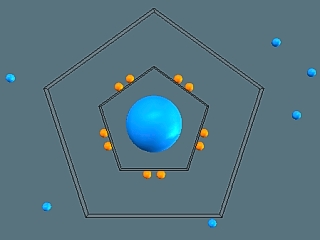NOTE:
You must be connected to the Internet the first time you view this simulation, at which point the codebase for all the simulations will be downloaded to your computer. This process make take a few minutes, as the codebase is roughly 9MB in size. Subsequent viewings of the applets will run from your local copy. |
|
| DESCRIPTION:
This java simulation illustrates how it is possible to charge
a conductor without having direct contact.
Here we are looking at a "hollow conductor", for example a hollow metallic cylinder, with an external charge inside of the hollow part of the conductor.
We charge by induction by first introducing the external charge into the hollow space in the interior of the conductor. If the external charge is large
enough, the charges within the conductor will be separated.
Next, we ground the conductor, which allows charges of the
same sign as the object to flow away. Finally, we unground
the conductor, and discard the object. The conductor is now
charged, and has the opposite sign of the original object.
|
|


